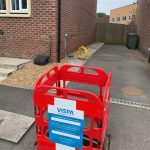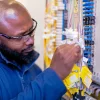MPs Back Bill Designed to Tackle Controversial UK Telecoms Poles

A small group of MPs have given their backing to a new Private Members Bill (PMB), which would make it mandatory for UK operators building full fibre (FTTP) broadband ISP networks to initiate a local consultation when deploying new telecommunications infrastructure in residential areas (e.g. telecoms poles).
The Telecommunications Infrastructure (Consultation) Bill, which was originally tabled by Hull MP Dame Diana Johnson (Labour), is largely being seen as a response to the massive increase in deployments of new Fibre-to-the-Premises (FTTP) broadband infrastructure across the UK (Summary of UK Full Fibre Builds).
Related deployments are governed by the Electronic Communications Code (ECC), which in the past was much more restrictive. However, this changed in 2016/17 via the Digital Economy Act, when the rules were softened as part of wider efforts to encourage mobile and broadband operators to upgrade their networks and expand coverage. Put simply, it became easier, faster and cheaper for operators to deploy their networks.
Advertisement
Most people welcome such builds and the huge improvement that flows from having access to gigabit-capable broadband connectivity or 5G mobile, although such work does tend to cause a brief period of local disruption. The unavoidable reality is that this often results in additional noise, traffic congestion, restrictions to property access, safety issues and complaints about the visual impact of the new infrastructure itself.
The Poles Dilemma
One of the most complained about aspects of this stems from the deployment of new telegraph / telecoms poles, particularly when built into an area that previously only enjoyed the benefits of underground infrastructure. But in some areas it would simply be too difficult to run new fibre underground, thus poles are used. But if poles cannot be used, then the operator may have to shelve their local deployment or cover fewer premises.
By comparison, deploying new trenches is a significantly slower and much more disruptive / expensive type of civil engineering, which can create all sorts of different problems for residents. But the latter does have the advantage of building a much more discreet, and some would say resilient (difficult to compare this aspect without more data), network.
Poles are typically built using Permitted Development (PD) rights, which means they don’t have to go through the usual planning process and can pop up quite quickly, often without residents getting much of a say, which adds to the frustrations of those who oppose them. Operators usually only need to give the most minimal of prior notices about this (e.g. sticking a notice to a lamp post), which are easily missed.
Advertisement
While poles will generally be installed on the publicly maintained highway, where the siting of a pole on private land would be both commercially and technically feasible and result in less visual harm, then the operator can also “investigate that option and give due consideration to its implementation“. But this is usually only used for big estates, business parks or on farmers’ fields etc.
Telecoms operators generally will not try to deploy poles on private gardens as that requires a legal wayleave agreement for access, which could also result in a counterproductive backlash from the community and may be more open to dispute (i.e. slows the deployment and adds costs). But we have seen some examples where this has taken place, although it’s usually by accident (here).
Suffice to say that such poles have a tendency to divide public opinion when they’re erected (examples here, here, here, here, here and here) and many of those with complaints often fear that such erections will hurt the value of their homes, but we’ve found no solid evidence to support this. Nevertheless, poles remain one of the least loved pieces of modern broadband and phone infrastructure (not unlike mobile masts).
On the flip side, poles are a very common sight across much of the UK, and you can find plenty of people who would be more than happy to accept their deployment if it meant gaining access to a full fibre network. Likewise, there seems to be no shortage of studies claiming to show how the provision of faster broadband tends to result in house values going up, rather than down (we’ve found no solid evidence for poles causing a fall).
Advertisement
Back in 2021 we asked 657 of our readers whether they would accept poles to get FTTP, if the alternative meant having to wait years longer for the service, and 71% said they’d take the poles. More recently we asked 400 readers if, when looking to buy a new house, the existence of poles in the street outside to carry fibre would be a major negative factor in their decision and 77% said no.
The New Bill
As above, the new Private Members Bill attempts to tackle this by proposing to require a “mandatory local consultation in relation to the installation of telecommunications infrastructure in residential areas; and for connected purposes.” But at the time of writing, the bill has yet to be fleshed out, and thus we’re unsure of precisely how wide its focus will be (e.g. will it extend to street cabinets and other apparatus).
Such a change would not be without significant consequences, since the whole reason for updating the ECC in 2016/17 was precisely to remove some of the red tape that had previously hobbled deployments of new broadband and mobile infrastructure. If you impose additional requirements, then you slow the whole process down and make it more expensive again, which in turn reduces the incentive of operators to build.
However, only a minority of PMBs ever become law (they can be tabled by any MP, not only those from the Government), but they do often serve a purpose by creating publicity around an issue and encouraging wider debate. In that sense, this bill has already generated some limited support from a number of MPs, and it will be interesting to see how it progresses.
As it stands, the bill is due to receive its second reading on Friday 18th November 2022 and this one will be crucial. Unless the Bill receives unanimous support from MPs and can pass 2nd Reading in the Commons without debate, it will not proceed further in the Bill process. But we doubt the government will support anything that disrupts their £5bn Project Gigabit programme, which is about to award its first supplier contracts.
Mark is a professional technology writer, IT consultant and computer engineer from Dorset (England), he also founded ISPreview in 1999 and enjoys analysing the latest telecoms and broadband developments. Find me on X (Twitter), Mastodon, Facebook, BlueSky, Threads.net and Linkedin.
« Ofcom Must Improve Protection Measures for EU Mobile Roaming
CityFibre Start £30m Gigabit Broadband Rollout in Rochdale »






















































So others must suffer if some grumpy old man doesn’t want a telegraph pole in his area?
Remains to be seen how far the bill will go in this area. Calling for a consultation is not the same as also making it easier to stop a build, although the two are often intertwined.
hmm yes who doesn’t want tons of poles with wires stretching across suburbia making it look like a 3rd world country. Yeah damn NIMBYs not wanting spaghetti cables and ugly poles everywhere, what are they thinking!
To be fair Billy, poles are common in a lot of modern countries – they’re by no means “3rd world” infrastructure. But hay, it could always be worse 🙂 :
https://www.reddit.com/r/cablefail/comments/3r8sc6/electricitytelephone_pole_india/
Mark that image is what I’m afraid of. Openreach duct access is sold to other companies. Maybe there will be a time when there are several altnets using openreach telegraph poles too. Then we’ll end up looking like that god awful image. I would much rather such cables were underground wherever possible they look disgusting to me. I don’t mind mobile towers, but poles with wires hanging everywhere just looks bad.
The thing is that people are all different. One group of people doesn’t mind, another does. This is why a consultation is a good thing. So that we don’t get group A saying muh nimby’s dont want it they’re bad people for not wanting these eyesores .. and group B can’t say I hate telegraph poles so nobody gets one. The day when it becomes unreasonable to ask the people what they want is the day we’ve sleepwalked ourselves into a dystopia.
This won’t happen as there are good safety restrictions on how much equipment can hang from UK poles.
And the UK does ask people what they want. They voted for Boris who promised gigabit broadband everywhere.
But maybe you’re right, maybe people thought it would happen by magic through the air and for free.
Must be a revelation to the United States and Japan, 2 of the world’s top 3 wealthiest countries, that the poles make them look like a third world country.
Openreach poles can’t look like the example above. There are examples of poles locally here with Openreach and 2 altnets on them. They are a plate extending like a small metal ear from the pole with small fibre CBTs on them.
If you want to see less mess overhead a really good way to make it happen would be petitioning Ofcom to allow the removal of copper once a property has full fibre – as has happened in a few other nations that have a bunch of overhead infrastructure and helped keep the poles less busy.
Alex, no poles where I live and yet FTTP from 3 providers. No need to be facetious about it happening by magic. Maybe you’ve never seen places without poles. Some places need poles others don’t. Last time I checked, Openreach can slap a pole wherever they want without asking for permission. They only have to notify the local authority, so no, people are not given a choice in these matters , you know the ones were talking about here before you went off on one about Boris for some reason.
I see the I must have internet at any cost people disagree (shocking) and think I should be shut down for objecting to poles. So therefore they’re right and everyone else is wrong, and yet they accuse me of the same. This must be what it’s like to be on a planning committee.
Picking USA as a choice for what looks 3rd world or not in terms of cabling… lol.
Just a quick one, have you ever been to the states? Seen the mess of poles they have in some cities? Messy cables that not only look bad but can also be unsafe isn’t exactly shouting out hey look at our amazing infra building capabilities.
@Billy, no poles mean underground and there are people who don’t like that either, certainly if they have a nice new driveway with block paving or something, and then it gets dug up for Fibre.
I don’t think altnets need permission either, as they are classed as infrastructure, as someone complained around here about the position of a cabinet, as they were going to have a driveway, and now they can’t. But they can’t do anything about it, so have heard.
We already have poles in most of the city anyway, it only a few newer estates that don’t, but I presume the ducting will be there due to normal copper lines going underground.
While my drive is not great, is mainly stones and is not in use, i am glad that Zzoomm is using the poles up where I am, so if I do decide to go withj them, it will be easier. One of the reason of not going for Fibre is because of the hassle of digging.
‘Just a quick one, have you ever been to the states?’
Yes. Most often California though also New York, New Jersey, Pennsylvania, Maryland, Massachusetts, Texas, Georgia.
The poles are far less densely loaded in the suburbs, with poles often serving far fewer premises than those in the UK. The infrastructure on the poles in the cities can look untidy however you’re in a city. Between mass transit, road signs and signals and the surroundings there’s plenty of overhead noise.
I’m not going to say the USA’s infrastructure is great but the assertion that above-ground telecomms means instant third-world status is absurd.
I have a pole just for my Enterprise line – place your bets on how long it takes BTO to start to use it for other stuff in the area? After all they cleaned out 14 blockages for it – so only makes sense to use the same route?
I hope not – but they probably will!
https://ibb.co/GFQThQd
@angry man
Is that you Anon?
Ban electricity pylons and turbines too.
And traffic lights.
And street lamps.
And oxygen.
Make Oxygen free apart from inside BMW’s and Audi’s I say – that would work 🙂
Controversial?
I have one on public land in front of my hedge. I’ve only ever worried about it in context that our neighbours’ tree to the left threatens to disconnect several of us as the wires go through the branches. The houses on the opposite side of the road are fed telephony by poles on our side, they have identical structures in their gardens on their side (there is no pavement) carrying overhead power from the substation 100m away.
This latter point is where co-ordination is needed. Our feeds are all 100A off a 100kW substation supply, and when EV usage takes off, will be insufficient. Even 2x 7kW chargers per house will break the system, and we may see 11kW or 22kW use take off in future if 3-phase supply was more common.
A new distribution grid is needed on the supply side (not the Gov’ts alternative to remotely prevent charging to defer demand) and this should present the opportunity to coordinate and put new distribution for power and fibre in at the same time. Sadly I see no sign that this looming energy delivery problem is being acknowledged, let alone a plan to tackle it.
I am not sure about telephone cables on poles, but in my lane the poles are owned by SP Energy Networks who come along and prune trees (at their expense) to avoid damage to their lines.
laughable that the internet junkies must get their fixes above anything else. Doesn’t matter that an operator has taken the cheapest route and ruined a lovely scenic village / village green / view with new poles and spaghetti cabling. Then other ALT networks come along and want to overbuild and put up even more poles and cabling strewn across streets.
Not everyone is desperate for internet and willing to accept vandalism in name of profit (i.e. the cheapest way). Its better, usually more weather resistant and tamper resistant to bury the cables where original poles did not exist.
Having said that, if its some town area that is all concrete, then it is going to matter much but WHAT is wrong in a so called democratic country for people to have some say over their area? If you don’t like your internet access and its THAT critical then simply move to an area where there is better connectivity – why should person wanting faster internet requirement override other people’s who would rather appreciate attractive place to live? You can move for faster internet but once poles go up and the mess of cabling, its permanent for that community.
The people that don’t want an eyesore are not against people getting faster internet; they just don’t want an operator OR multiple ALTNETS erecting poles because its the cheapest route, and in some cases insisting that a pole is put on their land. The operators could increase an install fee if they have to spend more to bury cables for example.
Completely agree, the Internet and being permanently connected to check how many likes you are getting shouldn’t mean other peoples amenity of their area is degraded. New poles should be prohibited, cable should be underground, that was always the ideal installation method for telecoms, and with more extreme weather predicted, having vital infrastructure strung along wooden poles pushed into the ground should be avoided from now on. FTTP is a modernisation of the telecom network, that should also include how it is installed.
When I was in Japan I remarked on how untidy the poles and overhead cables looked. I was told they had no option, even in historic cities, as they would otherwise suffer in earthquakes. Japan is not a third-world country by any stretch, but the result looks pretty awful.
The reasoning does not make much sense, why would poles be more resistant to damage from earthquakes? If anything they fall more easily than trees, or cabling that is protected in ducts
When the ground is literally moving how do you rate the chances of ducts with no flex as they’re buried versus poles that may sway and bend somewhat? I’m pretty sure the Japanese have become quite adept at dealing with earthquakes and if they say that overground infrastructure is safer it seems reasonable to trust their experience.
The simple solution is, when FTTP is installed, remove all the copper wiring from the current poles and force everyone over to FTTP. Tell those who complain that its better than having two poles.
The issue above is more about when poles are deployed in areas that haven’t had them before.
But then the question presents, how were they getting their current phones over the copper wire? It simply must be the case that they were getting them by an existing pole. As if not they were going underground and Openreach could use that underground system if that is the case.
Most of the time where poles are installed in areas that were previously underground copper it’s because the copper is direct in ground cable, no duct for fibre to go into.
Literally can’t re-use that infrastructure, there’s none to re-use. Have to either dig from the beginning or use poles. Digging can be cost-prohibitive.
If this bill passes though Govt and is made law then it will mean even more red tape for all concerned and slow down the rollout of both FTTP and 5G infrastructure to a glacial pace therefore while in some cases it is fair to have a consultation where planning permission has been requested, I believe this bill doesn’t help anyone and instead will offer nothing but cripple the UK’s rollout of both FTTP and 5G technology when the UK should be doing all it can to speed up the rollout for example using bandwidthplace.com data for April 2022, the UK is in 47th place with a average of 92.63Mbs compared to Romania in 5th place with a average speed of 214.33Mbs in fact 25 countries in Europe have much faster Internet then the UK with only 13 countries in Europe have slower Internet then us which is a international embarrassment as we should be within the top 10 of Europe for fixed broadband speeds.
Hence why this bill should be killed off at the earliest opportunity and why I hope the Govt doesn’t support it.
The Electronic Communications Code absolutely looked at how red tape could be removed, and it’s taken several years of test cases and challenges for the effects to be felt. But the aim was also to allow Telecommunications to be treated as simply infrastructure, not a special (pejorative) case.
This law would also affect small cells, and potentially overrule the parts of the European Electronic Communications Code which reduce small cell planning red tape.
And frankly – back to that first paragraph – lamp-posts, traffic signs, bollards, bus shelters and other local authority infrastructure is quietly deployed without any apparent need for consultation or oversight, and that’s even deployed at our direct expense!
They love that red tape.. red tape = more pretend work for them to do = more money in certain peoples pockets.
Its all big money shifting around, scams left right & centre.
I’m all for progress and getting on with things but have to agree that there is a risk companies will take this cheaper/lazy route and we’ll end up with unnecessary amounts of new poles and cables everywhere, which look awful. If it is the only viable solution then that is fine and of course using existing poles where suitable is a no brainer as well.
Needs to be a locally democratic process to add poles to an area.
I would say it needs to be a supermajority of residents/landlords where the “front”/”street” elevations have sight of the pole (with some sensible grouping–i.e. multiple poles in a village decided together as all or nothing by a larger plebiscite group) with a possibility for landowners to appeal positioning of poles on their land or near their vehicular access (as opposed to poles on public land).
In many cases if the public doesn’t want poles then they will be limited to copper final mile or 4G/5G (with operators going through a permitting process for additional mobile masts for signal enhancement)
And if you think messy cables overhead are bad in US/Japan, take a look at some off-prime city streets in Seoul, South Korea! Some parts of Europe are also pretty bad
When was the last time your opinion was sought on putting in lampposts, traffic signs, bollards and bus shelters? And you pay for them!
Boomers crying and screaming to get their own way yet again. Such a selfish generation.
I’m 29. But nice generalising there.
I would definitely not want a pole outside my window and I’m 32
Try having a street light outside your window. When I lived with my parents there was a street light right outside my bedroom window, had to have thick curtains to block out the light. I have one outside this room, which I used to use as a bedroom, it is across the road, but used to shine in here. They have converted it to LED now, so it doesn’t shine in here, then again, now it is almost useless as a street light.
In the mail newspaper today
“Grandmother, 75, gets police caution after refusing to move in successful sit-in pavement protest against broadband pole being erected outside her bungalow”
Hi all this is due to multiple poles being placed in Hull due to no PIA access as KCOM is the primary ISP. In some areas of hull there are two poles outside a lot of people’s frontages, one from KCOM the other another provider. Looks a complete mess.
So Kcom charges way more than altnets but chooses the cheapest route, interesting
I know most of the recently covered complaints in Hull have been about Connexin, I can sympathise with residents since they already have access to fibre from KCOM via ducts or existing poles.
I’m not sure how the other operators are rolling out but as far as I’m aware I and most of the area are served by KCOM via poles, are we we going to end up with 3+ poles outside properties? (KCOM, MS3, Connexin)
As you say it seems to be the lack of requirement for PIA from KCOM is the real issue, as far as can work out Ofcoms last review determined that anyone building a seperate network was unlikely so didn’t think physical infrastructure access intervention was required.
Connexins response to the last Ofcom consultation included asking for PIA back in 2020.
I wonder if the operators or MPs have tried to get Ofcom involved in the PIA aspect rather than adding consultation requirements that seem to get ignored for PD anyway.
Forcing KCOM to offer PIA does seem quite damaging to them if competition gets relatively cheap access to their 300K footprint, they’ll have lots of space on the poles once the copper is no longer used though 🙂
If Openreach want to installed a pole for future FTTP in my area – I welcomed it. Rather than difficulties underground work and it too costly for them to do it.
Here, heavily populated poles like in the picture are used for final house distribution supplied from ducts. I would expect extra poles when fibre arrives as the hardware tends to be more bulky and would overload the poles when added to the copper.
If an area was previously supplied by ducts, that should act as a precedent and new infrastructure installation should respect that.
Noticed some contractors (for OR) putting ducts in a local estate where I worked with a planner in the late 60s putting the original copper cable in. From what I can remember it was not ducted originally. So it can be done. Outside my property there is the copper to each property and the fibre has just been put in to each pole. Does look untidy, hoping it gets tidied up on demise of copper.
It can certainly be done. It just costs £500+ per premises instead of £2-300 using existing poles. Openreach do it all the time, but at the end of rollouts usually when they’ve done the easier bits and have budget left to plug the more expensive and slower gaps.
Best take down all the pesky street lights too!
Yeah, then we will be able to see the stars at night.
It’s like the pole they put up for my business line. I know they will use it for others in the future as there are 3 other poles nearby – but mine is the only line on it as they could only the last 300M overground to the point it goes under the drive at the end of the road. There was a sign on it saying people could object for so many days after it was put in – but no one has as far as I know – they all have Virgin anyway
4 poles won’t carry a line 300m
I would have thought that narrow trenching and micro ducting would make it unnecessary to install some poles.
Adding my two cents because I can.
Telegraph poles are part of the scenery across the land. It annoys me that in my area that are so few! Any time BT need to do work they automatically have to dig up the road. It’s annoying.
Just pandering to the NIYMBYs.
So many angry people.
We have had Brsk and 6g putting up there own poles on the Sam street where I live
In most rural communities the poles are already there for power distribution and the housing densities are low so you won’t get the situations shown. Pretty soon you will need decent internet – TV, radio will go streamed – and it will become really difficult to sell your home if all you can offer is 2Mb/s! Installing on poles is just so much cheaper than new ducts or even burying fibre in a field.
Years ago Openreach erected a pole on a verge which our land, it carries one domestic phone line. I wish Openreach would put in equal effort when domestic customers would like to order FTTP !
They have to pay the first £3400 to deliver copper to premises with no existing service.
FTTP no such regulation.